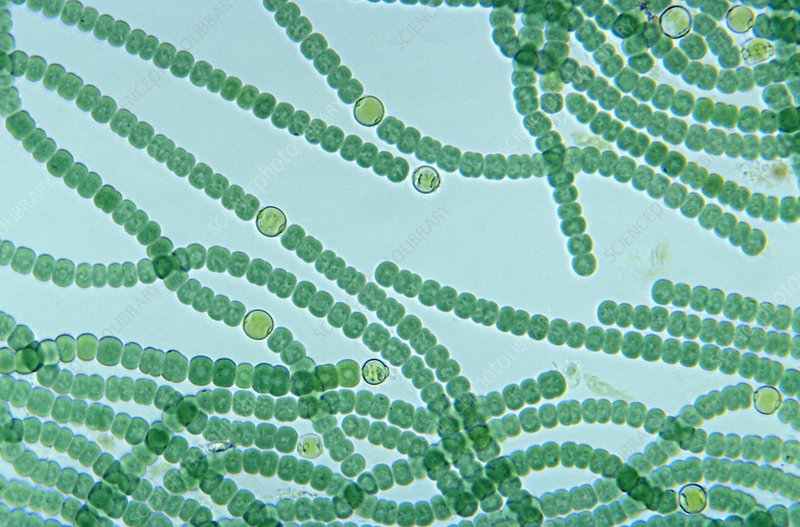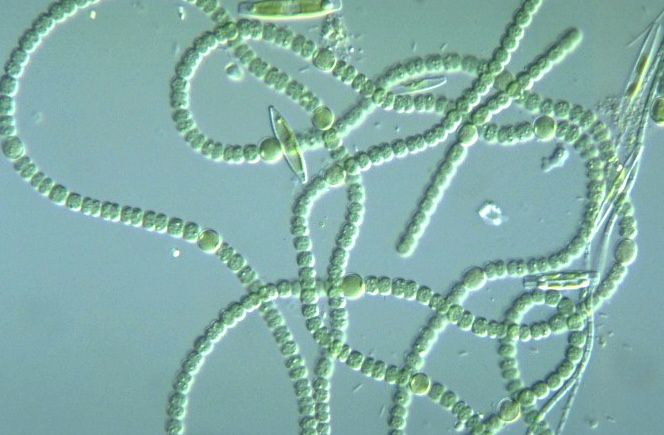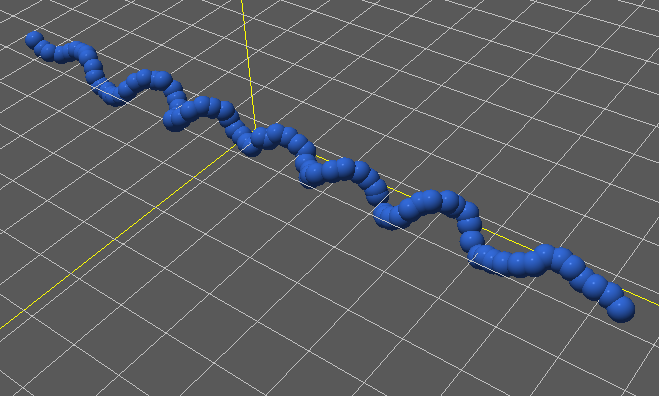Worm Like Chain¶
Cyanobacteria often form worm-like filaments and may grow in large masses or “tufts” one meter or more in length. Some are unicellular, a few form branched filaments, and a few form irregular plates or irregular colonies. Cyanobacterial cells usually divide by binary fission, and the resulting cells may separate to form new colonies. Some of the filamentous cyanobacteria are motile by means gliding or rotating around a longitudinal axis,
This model starts a worm-like chain and introduces the Mechanica Bond and Angle Bonded Interactions to create a very simply bacterial filament model. This model does not include self-propelled particles, we will introduce these later.
In many bacterial filaments, each bacterial cell sticks to at most one or two
neighbors. We can not use a non-bonded type potential for this, as a non-bonded
interaction would stick to all bacteria with a range. Instead, we use a
Bond to explicitly bond pairs of bacterial cells. Bacterial filaments
tend to have a certain stiffness, we use a Angle to model this resistance
to bending.
We can create a filament starting with the standard simulation setup:
# potential cutoff distance
cutoff = 8
# dimensions of universe
dim=np.array([20., 20., 20.])
center = dim / 2
# new simulator, don't load any example
m.Simulator(dim=dim, cutoff=cutoff)
We approximate a bacteria with a simple spherical Bead. For the time being, we ignore the fact that bacteria in fact tend to be lozenge shaped. We’ll cover non-spherical particles later:
class Bead(m.Particle):
mass = 0.4
radius = 0.2
dynamics = m.Overdamped
Use over-damped dynamics to model Brownian motion. To represent steric occlusion, add a soft-sphere interaction potential to the bacterial particles. This form of the potential creates a slightly compressible bacteria, and with a non-zero epsilon term, is slightly attractive to other bacteria:
pot_bb = m.Potential.soft_sphere(kappa=20, epsilon=5.0, \
r0=0.2, eta=4, tol=0.01, min=0.01, max=0.5)
Use a harmonic potential to model the attachment of neighboring cells:
# harmonic bond between particles
pot_bond = m.Potential.harmonic(k=40., r0=0.2, max = 2)
And a harmonic_angle potential to represent this stiffness of the filament:
# angle bond potential
pot_ang = m.Potential.harmonic_angle(k=20, theta0 = 0.85*np.pi, tol=0.1)
Attach the non-bonded potential to the Bead type, this will cause all instances of the bead to be able to push on each other, and give them a definite shape:
# bind the potential with the *TYPES* of the particles
m.bind(pot_bb, Bead, Bead)
Make a random force to apply to the beads, In over-damped dynamics, we need a random force to enable the objects to move around, otherwise they tend to get trapped in a potential:
rforce = m.forces.random(0, 1)
Bind it just like any other force:
m.bind(rforce, Bead)
We want to start our filament basically oriented in a line, so make a numpy array of contiguous positions for the x axis, and hole the y and z fixed. We will iterate over this array of positions, and create a new Bead particle for each one. Recall that a Bond connects adjacent pairs of bacteria, but a Angle is a 3-body term, so we need to attach it to each bacterial cell, but we need to keep track of the previous and next cells:
# make a array of positions
xx = np.arange(4., 16, 0.15)
p = None # previous bead
bead = Bead([xx[0], 10., 10.0]) # current bead
for i in range(1, xx.size):
n = Bead([xx[i], 10.0, 10.0]) # create a new bead particle
m.Bond(pot_bond, bead, n) # create a bond between prev and current
if(i > 1):
m.Angle(pot_ang, p, bead, n) # make an angle bond between prev, cur, next
p = bead
bead = n
And finally run the simulator:
m.Simulator.run()
The simulation output shows filament, you can play around with the initial positions, natural angle, bond and sphere stiffness.
The complete simulation script is here, and can be downloaded here:
Download: this example script:


